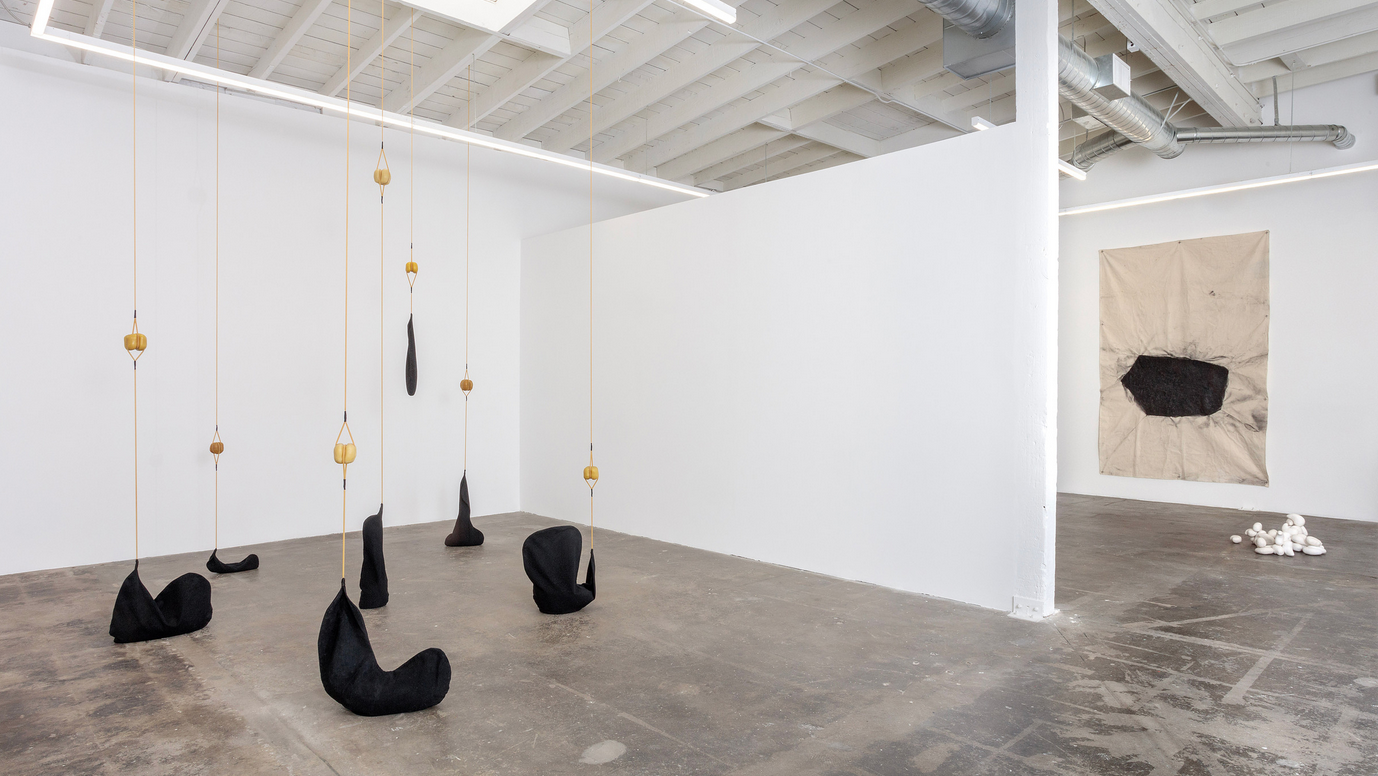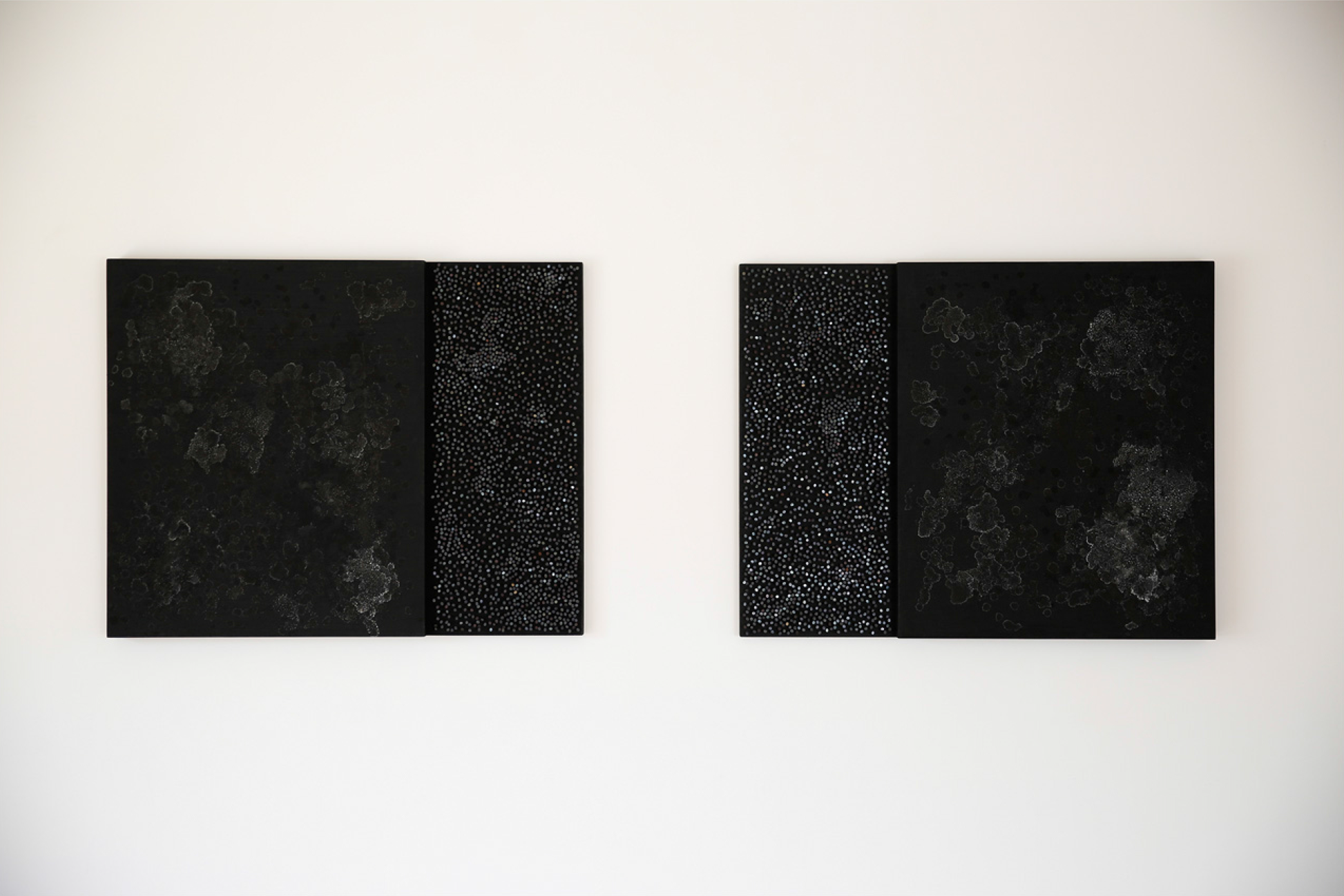BLACK WAX (2018)
Writing.
 Daniel Silva’s solo show “We Are Experiencing Some Turbulence Please Stow Away Your Electronic Devices” on display at Baert Gallery on April 2018.
Daniel Silva’s solo show “We Are Experiencing Some Turbulence Please Stow Away Your Electronic Devices” on display at Baert Gallery on April 2018.WHERE’S THE WORK?
BLACK WAX by Jasmin Blasco.
Material warmth in Daniel Silva’s practice.
Daniel Silva’s recent works, developed during a residency in Japan, expand his practice by including locally sourced materials such as cotton fabric (used for sails in fishing boats), rice and squid ink. His suspended pieces, rice-filled sacks of cotton, dyed black, carry a deceptive amount of kinetic energy. They trap their beeswax strainers in a rubbery suspense between floor and ceiling — not ascending or descending but, pending a distention-inducing rise in temperature, simply there.
The wax pieces, similar in appearance to the high-voltage ceramic insulators found in Japanese power lines, are presented as an effecting and effected presence in a network of forces. Silva’s sculptural compositions often feature an ensemble of similar but distinct elements, so that each piece cannot be reduced to its individual components, but must be apprehended formally as a non-hierarchical grouping. Elsewhere, fist-sized plaster pieces, inhabited by magnets, are positioned as elements in a relational field of attractors and repulsors — a flow of possibility and permutation. Identity is ascribed to the potential configuration of this grouping, rather than the particular instance of their arrangement, contrasting a snapshot with a dynamic, system-based proposal.
As a shifting, malleable substance, beeswax is central to Silva’s practice. Reflecting an interest in how a material will represent its environment, he indicates that wax produced by a given bee colony will display the characteristics and qualities of its surroundings: the flowers, season and weather conditions present when the wax was produced. As a result, beeswax is framed as the product of the swarm’s ecological relationships, the emergent result of the organization of a singular body composed by a multitude. Silva’s interest in the product of a swarm organism is echoed by his intuition towards a conception of the lived experience as a multiplicity of sensory modalities — one where sight is not privileged over touch, smell, taste or hearing.
Silva completed his MA in fine arts with a focus in photography at Central Saint Martins, where his practice morphed into a reflection on the sensual limitations of the digital image. Pushing back from the proliferation of images in print and on screens by proposing a multi-sensory experience, Silva began an investigation into the sensual qualities of material processes, conceiving of his materials in a dynamic relationship with the contingencies in their environment — processes occurring in a time frame that may exceed our immediate perceptive grasp.
If Silva’s formal device is the ensemble, and his material thinking is that of a flow of transforming qualities, his approach to structuring time-based material is decidedly dialogic. Silva, in collaboration with the musician Antonio Espinosa Holguin, composed a sound piece organized along the principles of contrapunteo, a traditional Colombian song style in which rhymes and ripostes are improvised (loosely analogous to a rap battle). The piece is broadcast overhead, featuring a background ambience and a palette of recordings that are deployed in counterpoint to one another. This algorithmically designed compositional system evades the narrative imposition of a score over the exhibit, instead choosing to evoke the environmental cues of the type of competitive call-and-response we might find in the animal kingdom.
As a traveling project, the works exhibited in We Are Experiencing Some Turbulence Please Stow Away Your Electronic Devices bare relationship to territory that must be ascertained. While clay pots have been broken as evidence of their travels, the processual marks left by Silva in — or rather with — various habitats, accumulate to register his position as one agent amongst many in a flow of information and matter. This potential antagonism is held in suspense through an understanding of material that encapsulates systems of relations, so that the materials — beeswax, squid ink, saltwater, charcoal — are all read as media registering the qualities of an ecosystem; the photographic logic of impression and development is still present in the charcoal rubbings on canvas or in the evaporated salt water stain works. In this context, territory may be understood as a sphere of mediated sensations, an encounter between human and non-human agency.
As evidenced by his interests in the acheiropoieta, the name given to Christian icons that are without human attribution and considered to be of divine origin, Silva proposes works that result from an interpretative contract between audience and artistic curation — a displacement of the conceit of single authorship as the origin of a work in favor of an interpretative trajectory. The poetics of the work appear here under the signifiers of emergent behaviors, decentralized structures, simultaneous multiplicities, algorithmic counterpoint and the divine.
Although it would be misguided to apprehend the works only through a linguistic modality, it is left to the observer (or rather the “senser”) to ascribe meaning to the effects of these particular assemblages of sensibility. A multi-modal encounter with the materiality of the biological world may indeed be spiritual in nature or more prosaic: is this food? The metaphor of stomachs filled with rice, denoting a digestive process, is interesting in this regard as it points towards a problematic that doesn’t erase the relationship of the audience on their environment as potential consumers. However, the ethico-political horizons of Silva’s ecologically framed practice may lay closer to what biologists call mutualism, a symbiotic arrangement that is beneficial for organisms of two different species.
With this exhibition-scale installation, Silva melts the tensions between sensation and cipher, between material flux and instantiated form, between group and individuals and between friend and food. The elegance of Silva’s work provides a space for sensation, his insistence on black pigments — surfaces that swallow light — de-center the primacy of the retina in favor of an embodied encounter, preparing us for the looming warmth of change to come.
- Jasmin Blasco. Los Angeles, May 2018.
Click here︎ to download the text in PDF.
